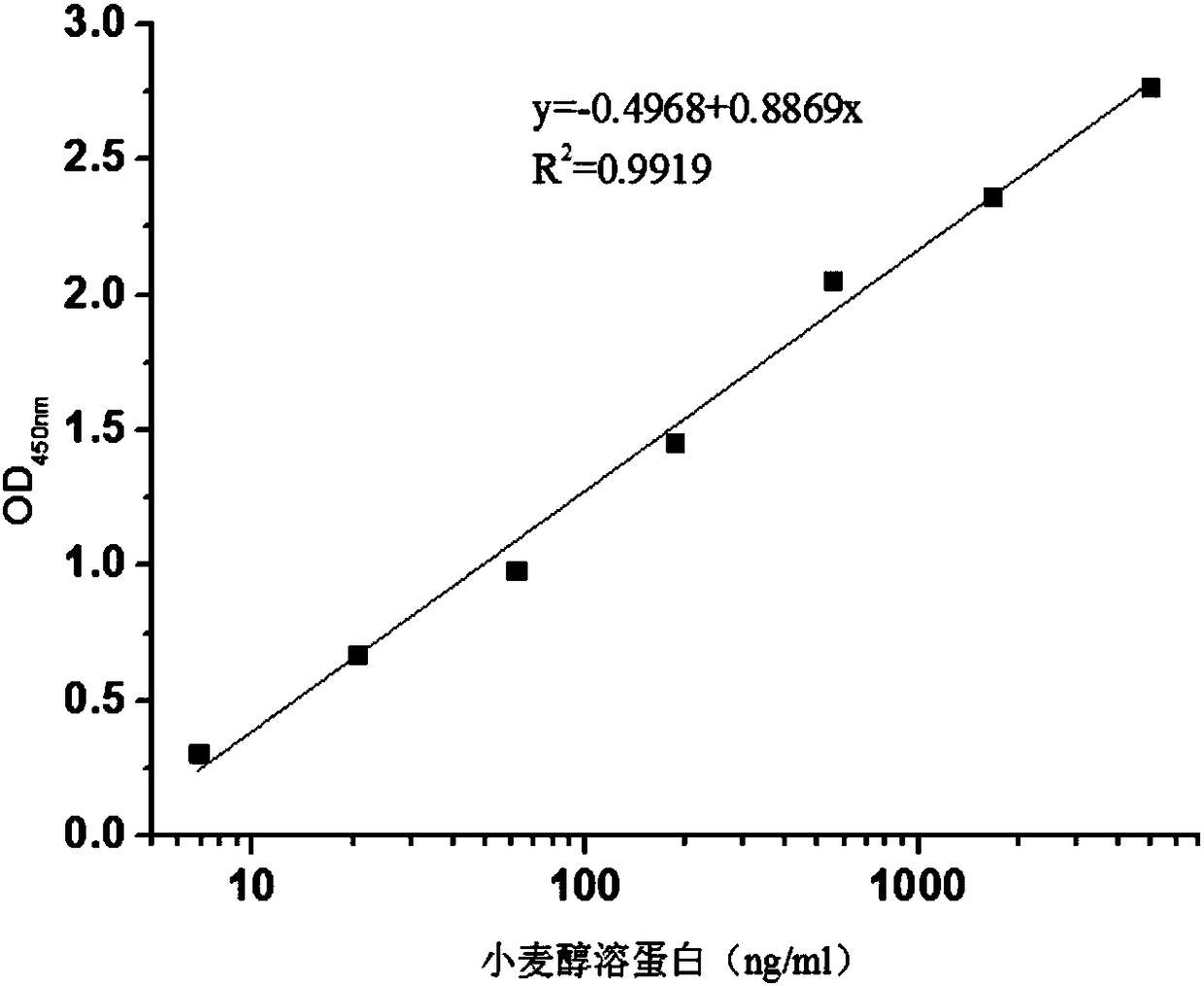Wheat prolamine monoclonal antibody hybridoma cell strain and its application
A wheat prolamin and monoclonal antibody technology, which is applied in anti-plant immunoglobulin, biochemical equipment and methods, material inspection products, etc., can solve the problems of high cost, restricting the development of allergen detection methods, and slow detection speed
- Summary
- Abstract
- Description
- Claims
- Application Information
AI Technical Summary
Problems solved by technology
Method used
Image
Examples
Embodiment 1
[0041] The preparation of embodiment 1 hybridoma cells
[0042] 1. Animal immunization: immunize healthy BALB / c female mice with a small-dose and short-cycle regimen. For the first immunization, mix 100 μg wheat prolamin with an equal amount of Freund’s complete adjuvant and inject subcutaneously. After an interval of 3 weeks, use 100 μg of wheat prolamin and the same amount of Freund's incomplete adjuvant were used for boosting immunization, and thereafter every 3 weeks with half of the amount of wheat prolamin for boosting immunization; the dose of sprint immunization was halved, and the intraperitoneal immunization was performed after mixing with an equal volume of normal saline. Using wheat gliadin as the coating antigen, the serum titer was detected by direct ELISA method;
[0043] The specific ELISA procedure is as follows:
[0044] (1) Coating: gradiently dilute the coated antigen with 0.05M pH9.6 carbonate buffer, 100 μL / well, and incubate at 37°C for 2 hours;
[004...
Embodiment 2
[0057] Example 2 Establishment of Double Antibody Sandwich ELISA Method for Detecting Wheat Prolamin
[0058] 1) Coating: Coat the microtiter plate with the antibody of cell line number CS6-1 at a concentration of 4 μg / mL, 100 μL / well, overnight at 4 °C;
[0059] 2) Washing: Wash the reaction plate three times with PBST, 3 min each time, 200 μL / well, and then dry the reaction plate;
[0060] 3) Blocking: add 200 μL / well blocking solution, and incubate at 37°C for 2 hours;
[0061] 4) washing: same as 2);
[0062] 5) Sample: Dilute the wheat prolamin with PBS to 5 μg / mL, and perform a three-fold gradient dilution; another PBS blank control is set. Add 100 μL sample to each well and incubate at 37°C for 1 hour;
[0063] 6) washing: same as 2);
[0064] 7) Add enzyme-labeled antibody (4F2-HRP, 2 μg / mL), 100 μL / well, react at 37°C for 1 hour;
[0065] 8) washing: same as 2);
[0066] 9) Color development: add substrate TMB 100 μL / well, and develop color for 12 minutes;
[0...
Embodiment 3
[0070] Taking wheat samples as an example to detect the allergenic component wheat prolamin
[0071] 1) Coating: Dilute the mouse anti-prolamin monoclonal antibody to the coating concentration with the coating solution, add 100 μL / well to the microtiter plate, and overnight at 4 °C;
[0072] 2) Washing: Discard the liquid in the wells of the microplate, wash the reaction plate three times with PBST, each time for 3 minutes, 200 μL / well, and then dry the reaction plate;
[0073] 3) Blocking: add 200 μL / well blocking solution, and incubate at 37°C for 2 hours;
[0074] 4) washing: same as 2);
[0075] 5) Sample: Gradient dilution of wheat prolamin with sample diluent, appropriate dilution of the sample to be tested, 100 μL per well, set positive control and negative control, and incubate at 37°C for 1 hour;
[0076] 6) washing: same as 2);
[0077] 7) Add enzyme-labeled antibody: Dilute the enzyme-labeled mouse anti-gliadin antibody to the working concentration, 100 μL / well, ...
PUM
 Login to View More
Login to View More Abstract
Description
Claims
Application Information
 Login to View More
Login to View More - R&D Engineer
- R&D Manager
- IP Professional
- Industry Leading Data Capabilities
- Powerful AI technology
- Patent DNA Extraction
Browse by: Latest US Patents, China's latest patents, Technical Efficacy Thesaurus, Application Domain, Technology Topic, Popular Technical Reports.
© 2024 PatSnap. All rights reserved.Legal|Privacy policy|Modern Slavery Act Transparency Statement|Sitemap|About US| Contact US: help@patsnap.com








